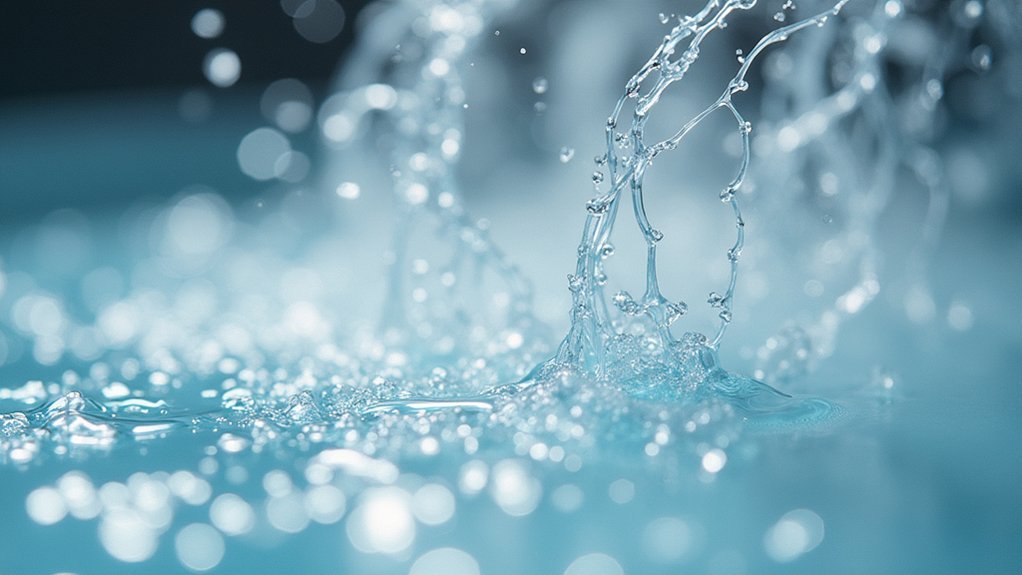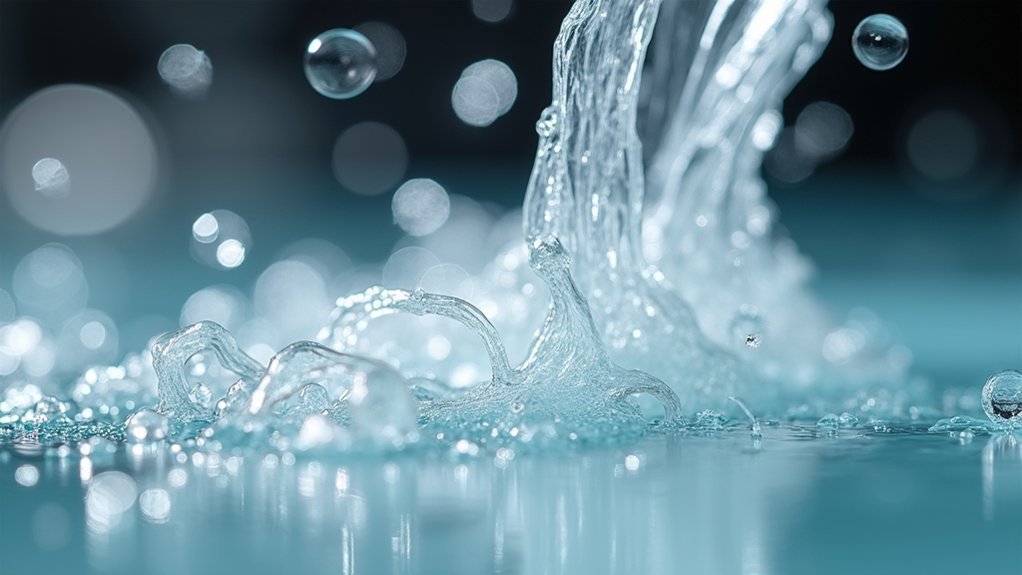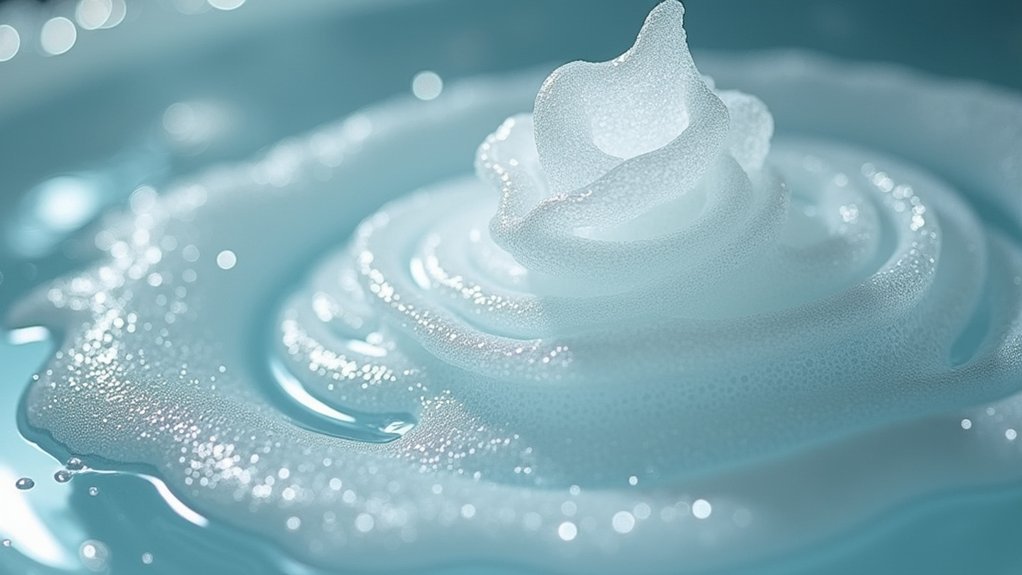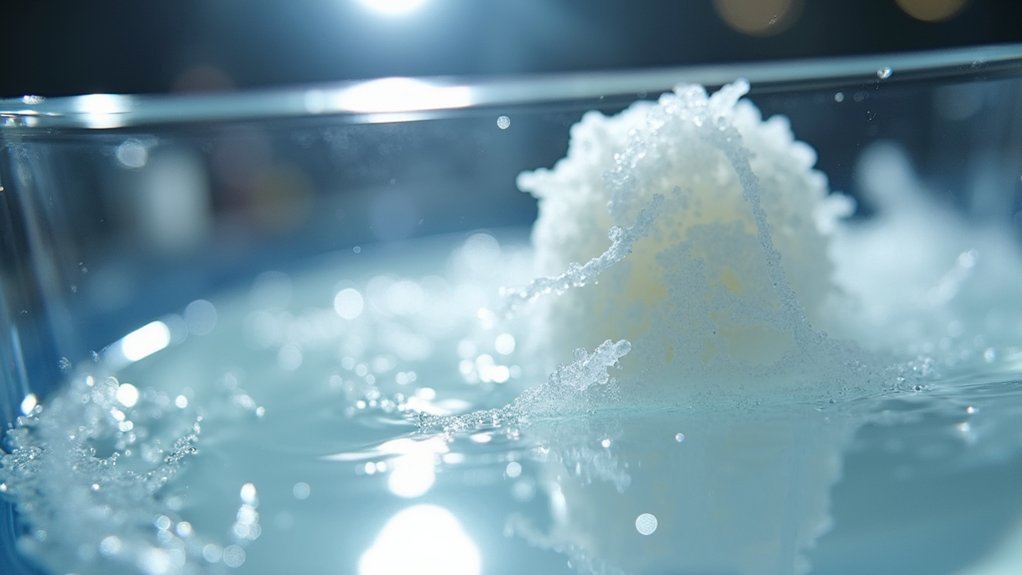You’ll dissolve PVA support material by first storing filament in airtight containers below 20% humidity, then printing at 185-200°C with proper bed adhesion. Submerge your finished print in warm water below 50°C, agitating regularly to accelerate dissolution. Pat the model dry with a soft cloth, rinse thoroughly to remove residue, then air dry completely. Proper temperature control and post-processing techniques guarantee you’ll achieve clean, professional surfaces that showcase the full potential of this water-soluble support system.
Understanding PVA Support Material Properties

PVA support material stands out as a game-changer for complex 3D printing projects because it dissolves completely in water, leaving behind clean, professional-looking surfaces.
This biodegradable polymer offers unique properties that make it ideal for creating intricate overhangs and complex geometries that would otherwise be impossible to print successfully.
You’ll find PVA support works perfectly with PLA filaments since both materials extrude at similar temperatures around 200°C.
However, you need to store PVA properly in airtight containers with desiccants because it’s highly hygroscopic and absorbs moisture from the air.
This moisture absorption can affect print quality and material performance.
When you’re ready to remove supports, simply immerse your printed part in water and watch the PVA support dissolve within hours.
Pre-Printing Preparation and Storage Requirements
Proper storage becomes your most important task when working with PVA filament, since this hygroscopic material will quickly absorb moisture from the surrounding air and become unusable.
You’ll need an airtight container with desiccants to maintain humidity below 20% relative humidity. Monitor these levels consistently to guarantee your support material remains in prime condition.
When PVA absorbs moisture, it becomes soft and sticky, creating loading failures and clogs during printing. You must dry damp filament before use to prevent stringing and poor extrusion quality.
Prepare your airtight storage container specifically for AMS and AMS lite systems if you’re using them. This preparation step directly impacts your printing success and the quality of your dissolved support structures.
Optimal Print Settings for PVA Support Structures

Five critical temperature and surface settings will determine whether your PVA support structures print successfully or create a frustrating mess.
Set your extruder temperature between 185-200°C to guarantee ideal melting and flow of the PVA material. Keep your heated bed between 45-60°C to promote adhesion while preventing lifting during printing.
Use a PEI surface or painter’s tape to enhance adhesion and prevent warping.
For dual extrusion setups, you’ll need to adjust your second extruder’s nozzle offset carefully to guarantee precise alignment and avoid unwanted material mixing between your main filament and PVA supports.
Enable dense support layers in your slicer settings to minimize PVA usage while maintaining excellent print quality throughout the process.
Water Temperature and Dissolution Techniques
Water temperature plays the most essential role in determining how quickly you’ll dissolve your PVA support material. You can use tap water at room temperature, but warm water will dramatically accelerate the dissolution process, reducing what typically takes several hours to just minutes.
Keep your water temperature below 50°C to prevent damaging PLA models. Create a heated water bath or simply use warm tap water for best results.
Agitate the water regularly to enhance dissolution rates, and consider pre-soaking your supports in warm water before attempting removal.
Monitor your print carefully during immersion to prevent water from entering internal cavities, which could damage your model.
Change the water periodically to maintain dissolution effectiveness throughout the process.
Monitoring the Removal Process

Once you’ve set up your warm water bath, you’ll need to watch the dissolution process carefully to achieve ideal results.
PVA supports can take several hours to over twelve hours to completely dissolve, so patience is crucial. Gently agitate the water periodically to break down the material more effectively and reduce overall dissolution time.
Check your model regularly to verify water hasn’t infiltrated the internal structure, which could cause damage or complications. Keep monitoring the temperature, maintaining it below 50°C to protect your PLA model from heat damage.
Monitor your model consistently to prevent water infiltration and maintain temperatures below 50°C to avoid heat damage to PLA components.
If excess support material remains after initial dissolution, consider pre-soaking the model again to expedite further removal and achieve clean results.
Post-Dissolution Care and Model Finishing
Once you’ve dissolved the PVA supports, you’ll need to focus on proper drying and curing to prepare your model for finishing.
Surface quality enhancement through careful sanding and coating can greatly improve your model’s appearance and durability.
You’ll also want to conduct thorough final inspections to confirm all support material has been removed and identify any areas requiring additional attention.
Drying and Curing Steps
The dissolution process marks only the halfway point of successful PVA support removal—proper drying and curing steps guarantee your model maintains its structural integrity and surface quality.
After removing your model from the dissolution bath, gently pat it with a soft cloth or paper towel. Don’t rub or scratch the surface. Position your model in a well-ventilated area for complete air drying.
| Drying Stage | Temperature | Duration |
|---|---|---|
| Initial Pat-Down | Room temp | 2-3 minutes |
| Air Drying | Room temp | 2-4 hours |
| Final Cure | Room temp | 8-12 hours |
If residual PVA persists, repeat warm water soaking below 50°C for PLA models. Once fully dried, apply protective coatings to enhance appearance and durability, especially for models requiring moisture resistance or frequent handling.
Surface Quality Enhancement
After PVA dissolution completes successfully, your model’s surface quality determines the final project’s professional appearance. The support interface areas require careful attention to achieve ideal results.
Start by rinsing your model thoroughly in clean water to eliminate any remaining residue and prevent water spots.
Then enhance the surface through these finishing techniques:
- Sanding: Use fine-grit sandpaper to smooth imperfections at support interface locations
- Priming: Apply primer to fill small gaps and improve paint adhesion for professional results
- Sealing: Use clear coat or sealant for surface protection and enhanced visual finish
You’ll want to verify your model’s completely dry before applying any paints or finishes.
This prevents moisture-related adhesion issues and guarantees ideal coating performance for your final project.
Final Inspection Techniques
Professional finishing requires thorough inspection to identify any overlooked issues that could compromise your model’s final appearance.
Begin by carefully examining all surfaces where supports were attached, particularly intricate areas and overhangs where PVA residues commonly persist. Use proper lighting and magnification to spot stubborn remnants that standard dissolution might’ve missed.
Remove any remaining material with a soft brush or compressed air, being gentle to avoid surface damage.
Check internal cavities for water ingress, which can weaken porous structures over time. Once you’ve completed the cleaning, rinse the entire model with clean water to eliminate loose particles.
Allow complete air drying before applying protective finishes like clear coats, which enhance appearance while providing moisture resistance for long-term durability.
Frequently Asked Questions
How to Dissolve PVA Supports?
You’ll dissolve PVA supports by immersing your print in warm tap water below 50°C. Agitate the water and monitor carefully to prevent internal damage. The process takes several hours.
How Do You Solubilize PVA?
You’ll solubilize PVA by immersing it in tap water for several hours. Warm water speeds up the process, but keep temperatures below 50°C. Gently agitate and monitor to prevent damage.
How to Dissolve PLA Supports?
You can’t dissolve PLA supports since PLA isn’t water-soluble. You’ll need to mechanically remove them using pliers, cutters, or break them away by hand from your printed model.
How to Get PVA to Dissolve in Water?
You’ll dissolve PVA by immersing it in warm tap water below 50°C. Gently agitate the water and break off excess material first. Monitor closely to prevent water from entering your model’s internal structure.





Leave a Reply